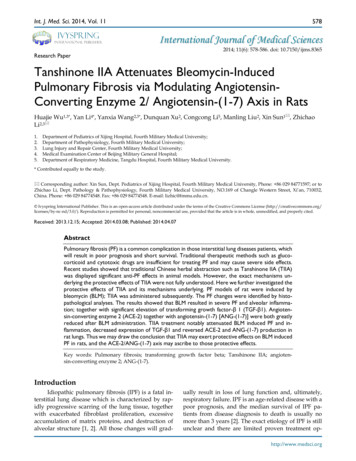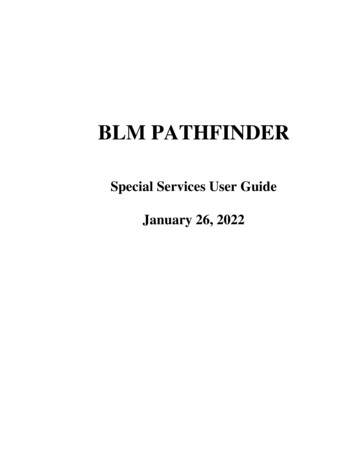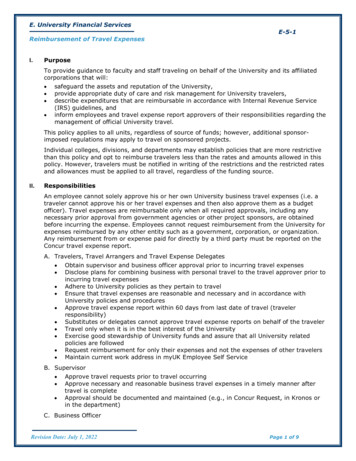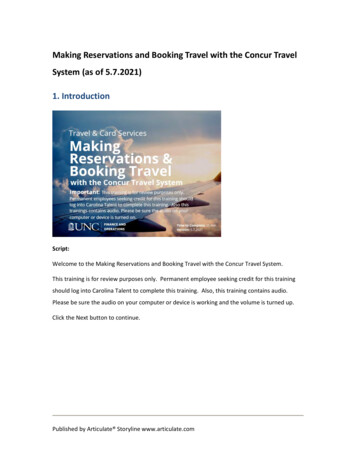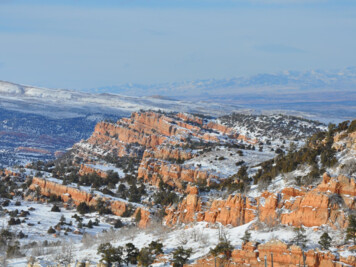
Transcription
BLM Travel Planning and ManagementParticipants will:1) Understand the minimization criteria and the applicationof the criteria within the phases of travel planning.2) Understand how objective based planning will allow yourtravel program to be comprehensive, interdisciplinary, aswell as address the minimization criteria.3) Understand your role as recreation planner in the phasesof travel planning and management.
BLM Travel Planning and , andEvaluationProjectImplementation(Specific Action)ImplementationPlan(Route NetworkPlanning)
Golden Rules of Travel Planning andManagementAll actions associated with travel planning andmanagement should:1) Be Interdisciplinary2) Be Comprehensive3) Demonstrate or make progress towardachieving the minimization criteriaMaintaining these key elements will result insuccessful travel planning and management.
InterdisciplinaryUtilize a diverse planning team to consider andaddress all resource and administrative accessneeds.
Comprehensive1.2.3.4.5.Addresses a wide variety ofuses and issuesExplores a variety ofsolutions to conflicts andissuesIdentifies and plans for alltravelers, with extraconsideration for theprimary traveler.Engages cooperators,stakeholders, and the publicEnsures access needs arebalanced with resourcemanagement goals andobjectives
Minimization Criteria?CFR 8342.1 Designation (aka minimization) Criteria (copy in notebook):Areas and trails shall be located to:1.Minimize damage to resources2.Minimize harassment of wildlife or significant disruption of wildlife habitats. Special attention will be given toprotect endangered or threatened species and their habitats3.To minimize conflicts between off-road vehicle use and other existing or proposed recreational uses of thesame or neighboring public lands, and to ensure the compatibility of such uses with the existing conditions inpopulated areas taking into account noise and other factors4.Not be in officially designated wilderness areas or primitive areas.
Our Role Within the Travel ProgramOur role as travel managers is to balance the needs oftravelers in support of other BLM programs, whileaccomplishing the minimization criteria.
BLM Travel Planning and , andEvaluationProjectImplementation(Specific Action)ImplementationPlan(Route NetworkPlanning)
BLM Travel Planning and ManagementRMP(AreaAllocations)At the RMP stage the Golden Rules require the Travel Planner to: Think in polygons or areas Establish objectives for the travel program that are tiered to the ? Work closely with planning team to develop alternatives addressingmultimodal forms of travel that support the objectives of: the Travel program Other programs impacted and/or influenced by travel decisions.
Homework1) Is this a good objective?2) How will this objective influence travelplanning and management within the RMP?– During Network or implementation planning?– During project decision making?– Inventory, Monitoring, or Evaluation?
Good Objectives:1) Have an obvious indicator that can bemeasured2) Contain a standard (measure of success orfailure)3) Are based on an outcome (end result,positive impact, or avoidance of a negativeimpact) not an input (the things we do)
Objectives establish the boundaries formanagement actions and future decisionsDo you think these twoare working from a goodobjective?Fight FireAggressively!What could be added toimprove their objective?Having Provided forSafety First
Objectives that influence travel:1) Come from other BLM programs and,2) From within the travel program itself.The objectives within the travel program shouldbe tiered to: ?
Travel Planning and Management at theRMP (Land Use Plan)The following area allocations support objectives andare required in all Land Use Plans:1) Open2) Closed3) Limited- I.E. type of vehicle, season, designatedroads and trails.
Optional RMP Decisions:An RMP may consider:1) Delineating andmapping TravelManagement Areas(TMA)2) Addressing uniquetravel managementcircumstances
Not RMP Decisions:The following are often confused as RMP decisions, theyare not:1) Authorized and Permitted Uses are addressedthrough the authorization or permit, not the LUP2) Accessibility- There is no legal requirement to allowpeople with disabilities to use motor vehicles onroads, primitive roads, trails, and/or in areas that areclosed to motor vehicle use.3) The validity of RS 2477 evidence or assertions
Back to the Golden Rules: Travel Decisions function to support theobjectives of other programs and theobjectives of the travel program Use of TMAs enhances comprehensiveness.– Facilitates addressing multimodal forms of travel– Facilitates addressing area or user specific needs– Allows travel planning to support other polygonalplanning designations and allocations (ACEC,SRMA).
ExerciseMatch the area objective with the travelmanagement decision.
Sustain or enhance the Johnny Behind the Rocks RMZ (5,594 acres) for motorizedrecreationists to engage in unencumbered motorcycle riding, OHV trail riding , androck crawling so that visitors report a higher than average realization of experienceand benefit outcomes listed in AppendixJ (p. 1377).1. Motorized TravelLimited to DesignatedRoads and Trails2. Motorized andmechanized travel islimited designated roadsand trails, closed tomotorized vehiclesDecember 1 to June 15,and closed to all travel(human presence) fromDecember 1 to April 30.3. Open4. Closed To MotorizedTravel5. Closed to Motorizedand Mechanized Travel
Sustain or enhance The Bus @ Baldwin Creek RMZ (1,159 acres) for non-motorizedrecreationists to engage in horseback riding, hiking, trail running, and mountainbiking so that visitors report a higher than average realization of experience andbenefit outcomes listed in Appendix J (p. 1377).1. Motorized TravelLimited to DesignatedRoads and Trails2. Motorized andmechanized travel islimited designated roadsand trails, closed tomotorized vehiclesDecember 1 to June 15,and closed to all travel(human presence) fromDecember 1 to April 30.3. Open4. Closed To MotorizedTravel5. Closed to Motorizedand Mechanized Travel
In the Lander Slope ACEC maintain and protect adequate winter forage and habitatfor elk and mule deer so as to support herd objectives.1. Motorized TravelLimited to DesignatedRoads and Trails2. Motorized andmechanized travel islimited designated roadsand trails, closed tomotorized vehiclesDecember 1 to June 15,and closed to all travel(human presence) fromDecember 1 to April 30.3. Open4. Closed To MotorizedTravel5. Closed to Motorizedand Mechanized Travel
Maintain the outstanding and remarkable ‘wild’ values of the Baldwin Creek NWSRUnit.1. Motorized TravelLimited to DesignatedRoads and Trails2. Motorized andmechanized travel islimited designated roadsand trails, closed tomotorized vehiclesDecember 1 to June 15,and closed to all travel(human presence) fromDecember 1 to April 30.3. Open4. Closed To MotorizedTravel5. Closed to Motorizedand Mechanized Travel
Maintain and improve habitat for greater sage-grouse in known concentration areas.1. Motorized TravelLimited to DesignatedRoads and Trails2. Motorized andmechanized travel islimited designated roadsand trails, closed tomotorized vehiclesDecember 1 to June 15,and closed to all travel(human presence) fromDecember 1 to April 30.3. Open4. Closed To MotorizedTravel5. Closed to Motorizedand Mechanized Travel
Maintain and improve habitat for greater sage-grouse in known concentration areas.1. Motorized TravelLimited to DesignatedRoads and Trails2. Motorized andmechanized travel islimited designated roadsand trails, closed tomotorized vehiclesDecember 1 to June 15,and closed to all travel(human presence) fromDecember 1 to April 30.3. Open4. Closed To MotorizedTravel5. Closed to Motorizedand Mechanized Travel
BLM Travel Planning and oute NetworkPlanning)
BLM Travel Planning and ManagementImplementationPlan(Route NetworkPlanning)The golden rules require the travel planner to: Plan for each and every line or route within the area. Including routeby route: Objectives and decisions Alternatives and analysis Work closely with planning team to develop a broad range of route byroute alternatives that address multimodal forms of travel in supportof the RMP objectives of: the Travel program Other programs impacted and/or influenced by travel decisions.
BLM Travel Planning and ManagementEstablish route by route objectives, alternatives, analysis, anddecisions that are tiered to the objectives contained in the RMP andthe minimization criteria?Somebody should invent atool to track all this routeby route information in away that links to it’sgeospatial features?Linking the routes GIS layer with an access database can create miracles. Such a smart filecan facilitate, create, and/or document route by route: public involvement, internal input,impact analysis, alternatives, decisions, monitoring, and evaluation.
BLM Travel Planning and ManagementImplementationPlan(Route NetworkPlanning)A travel Plan includes many important elements, however the maincomponent is the: Criteria to select, reject, or mitigate specific transportation linearfeatures in the final network; to add new roads, primitive roads ortrails; and to specify route specific limitations.Where should this criterion flow from?
BLM Travel Planning and ManagementImplementationPlan(Route NetworkPlanning)Good route selection criteria should be: Issue specific Quantifiable or Measurable Based on Existing Data Tiered to ?, TMA Objectives, and other pertinent RMPObjectivesGreat route selection criteria is all of the above plus it: Can be mapped and analyzed through GIS products Is stratified across the TMA in occurrence, abundance, and/orquality.
BLM Travel Planning and ManagementImplementationPlan(Route NetworkPlanning)Activity: An example of a route selection criteria will come across thescreen, your job is to rate this as Great, Good, or Needing Work.
Roads will not impact mapped sage grouse habitat.100% of the TMA is Sage Grouse Habitat.GreatGoodNeeds WorkA better selection criteria would be:“Route densities, locations, and/or useperiods will not disturb Sage GrouseBreeding and Nesting Areas”
All County Rights of Ways will remain open to motorized travel. The county has submitted a mapthat includes numerous RS 2477 assertions. Adopting this criteria would essentially result inall routes remaining open to motorized travel.GreatGoodNeeds WorkTrick question: RS 2477 assertions or claimsdo not influence travel planning, we makedecisions on these routes independent ofthe RS 2477 assertions or claims.
Routes locations and densities will be consistent with the prescribed setting for theSRMA. The SRMA encompasses half of the Travel Management Area.GreatGoodNeeds WorkA better selection criteria would be:“Route locations, densities, and uses will beconsistent with the prescribed setting for theSRMA and/or support the achievement of theSRMA Outcome objective”
No route will cause a physical impact or change in the aesthetic qualities of historic orprehistoric resources. 5 of these sites exist randomly within the TMA.GreatGoodNeeds Work
So what happens when a route doesn’t meet one or moredecision criteria?What do you think aresome alternatives toaddress a route that doesnot meet decisioncriteria?To close or not toclose, that is nolonger the questionLots of options here: Change in authorized traveltype Seasonal closure Upgrades/improvements Reduce use frequencies Informational Signing Noise abatementrequirements Modify route toaccommodate differenttravel modes (e.g. road totrail) Change in other visitorservices
So what happens when a route doesn’t meet one or moredecision criteria?How can our Recreationbackground help us withroute network planning?To Close or not toclose, that is nolonger the questionFrom our work within the recreation program we know that: Limiting the amount of group use, limiting destructive activities, influencing behaviors,concentrating use, utilizing or creating hardened sites, and shielding areas from usereduces environmental impacts from recreation (REF 1892) Taking a holistic look at why people travel these routes may result in new, unique, andmore effective management options.Doing so may require pairing recreation management plans with travel plans.Table Mesa (Phoenix AZ) ronmental library/rec mgmt plans/table-mesa-docs.html
Back to the Golden Rules: Network planning functions to support the RMP objectives ofother programs and the objectives of the travel program. Plans must demonstrate how route by route analysis, alternatives,and decisions address achievement of the minimization criteria. Use of GIS will improve data management and decision making. To be comprehensive and interdisciplinary plans should focus on:– Implementing RMP objectives and decisions.– Addressing travel issues with a broad range of alternatives inconsideration of why and how travel occurs within the area.
BLM Travel Planning and n(Specific Action)ImplementationPlan(Route NetworkPlanning)
BLM Travel Planning and ManagementProjectImplementation(Specific Action)At the Project Implementation stage the Golden Rules require theTravel Planner to: Be thinking in points or line segments Initiate projects to implement the RMP and/or network plans Initiate projects to address non-compliance issues (with the RMP,Network Plan, and/or the ?) identified during inventory,evaluation, and monitoring.
BLM Travel Planning and ManagementProjectImplementation(Specific Action)
BLM Travel Planning and ManagementWhere did wealready talkabout indicatorsand standards?RMP(AreaAllocations)We monitor indicators toensure plan conformanceand,Inventory,Monitoring, andEvaluationProjectImplementation(Specific Action)Inventories provideinformation to supportplanning,We evaluate monitoringdata against planningstandards to determine ifadditional action orplanning is neededImplementationPlan(Route NetworkPlanning)
BLM Travel Planning and ManagementInventory,Monitoring, andEvaluationAt the Inventory, Monitoring, and Evaluation stage the Golden Rulesrequire the Travel Planner to: Utilize planning documents to identify indicators and standards formonitoring and evaluation. Coordinate the interdisciplinary monitoring efforts associated withtravel planning Produce inventory information to support planning needs,
Compare and ContrastPoint or Line SegmentNetwork of LinesPolygonsProject Implementation(Specific Action)Implementation Plan(Route NetworkPlanning)RMPInventory, Monitoring,and Evaluation Develop inventoryinformation tosupport planningneeds Utilize planningdocuments to identifyindicators andstandards formonitoring Initiate projects toimplement plandecisions or addressnon-compliance Establish route byroute objectives,alternatives, analysis,and decisions Develop a broad rangeof route by routealternatives thataddress multimodalforms of travel(Area Allocations) Establish areaobjectives andallocations in supportof other programs andthe minimizationcriteria
BLM Travel Planning and itoring, andEvaluationProjectImplementation(Specific Action)ImplementationPlan(Route NetworkPlanning)
RMP(AreaAllocations)Inventory,Monitoring, andEvaluationProjectImplementation(Specific Action)ImplementationPlan(Route NetworkPlanning)
RMPGood objectives here(AreaAllocations)Make for betterproducts hereInventory,Monitoring, andEvaluationProjectImplementation(Specific Action)ImplementationPlan(Route NetworkPlanning)
RMP(AreaAllocations)Inventories provideinformation to supportplanning,We monitor indicators toensure plan conformanceand,We evaluate monitoringdata against planningstandards to determine ifadditional action orplanning is neededInventory,Monitoring, andEvaluationProjectImplementation(Specific Action)ImplementationPlan(Route NetworkPlanning)Carrying the golden rules oftravel planning andmanagement through eachphase causes the next phaseto get easier.
Questions
BLM Travel Planning and Management Inventory, Monitoring, and Evaluation RMP (Area Allocations) Implementation Plan (Route Network Planning) Project Implementation (Specific Action) . Roads will not impact mapped sage grouse habitat. 100% of the TMA is Sage Grouse Habitat. Great Good Needs Work A better selection criteria would be:
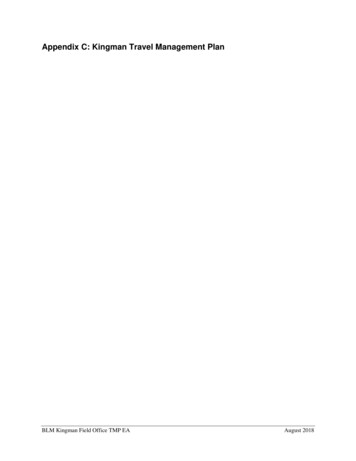

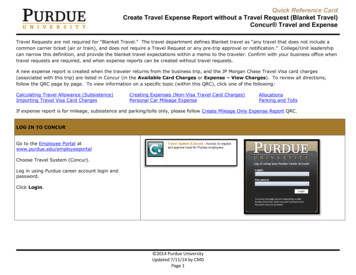
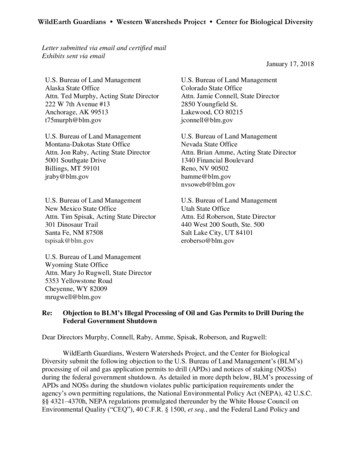
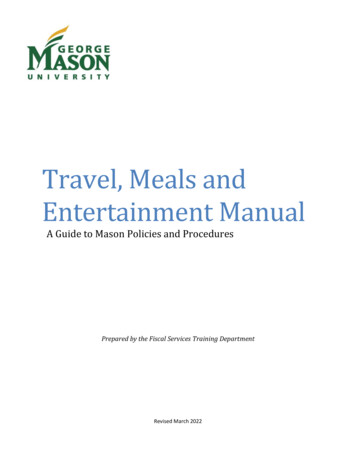
![State Protocol Agreement Between the Colorado State Director [Sd] of .](/img/43/co-20protocol.jpg)
